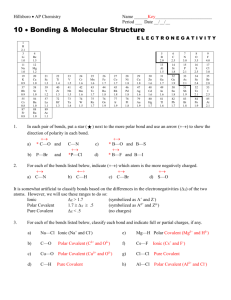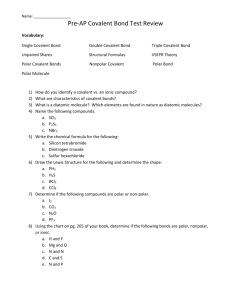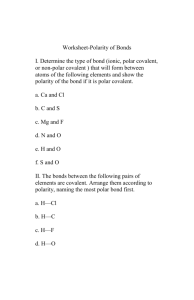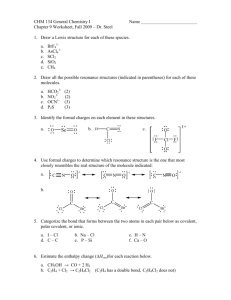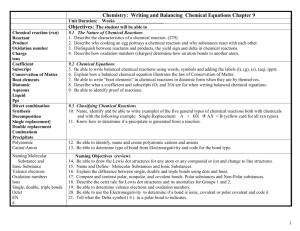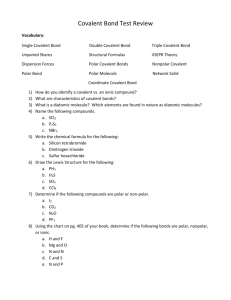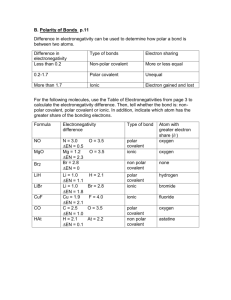South Pasadena • AP Chemistry
advertisement
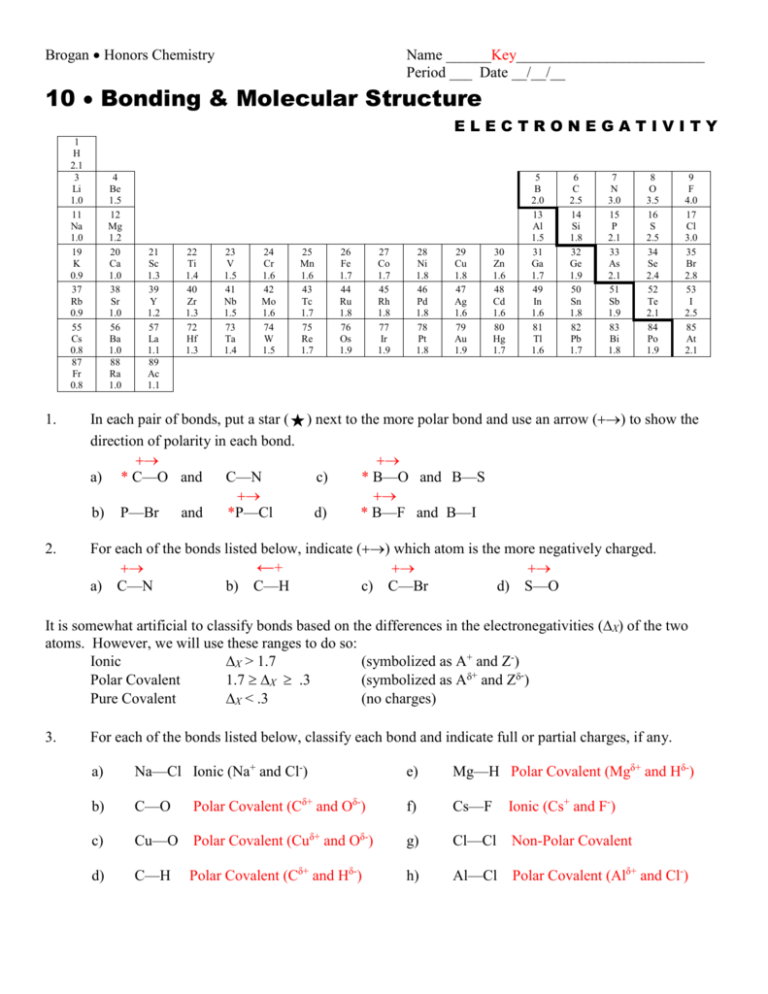
Brogan Honors Chemistry Name ______Key_________________________ Period ___ Date __/__/__ 10 Bonding & Molecular Structure ELECTRONEGATIVITY 1 H 2.1 3 Li 1.0 11 Na 1.0 19 K 0.9 37 Rb 0.9 55 Cs 0.8 87 Fr 0.8 4 Be 1.5 12 Mg 1.2 20 Ca 1.0 38 Sr 1.0 56 Ba 1.0 88 Ra 1.0 21 Sc 1.3 39 Y 1.2 57 La 1.1 89 Ac 1.1 22 Ti 1.4 40 Zr 1.3 72 Hf 1.3 23 V 1.5 41 Nb 1.5 73 Ta 1.4 24 Cr 1.6 42 Mo 1.6 74 W 1.5 25 Mn 1.6 43 Tc 1.7 75 Re 1.7 26 Fe 1.7 44 Ru 1.8 76 Os 1.9 27 Co 1.7 45 Rh 1.8 77 Ir 1.9 28 Ni 1.8 46 Pd 1.8 78 Pt 1.8 29 Cu 1.8 47 Ag 1.6 79 Au 1.9 30 Zn 1.6 48 Cd 1.6 80 Hg 1.7 5 B 2.0 13 Al 1.5 31 Ga 1.7 49 In 1.6 81 Tl 1.6 6 C 2.5 14 Si 1.8 32 Ge 1.9 50 Sn 1.8 82 Pb 1.7 7 N 3.0 15 P 2.1 33 As 2.1 51 Sb 1.9 83 Bi 1.8 8 O 3.5 16 S 2.5 34 Se 2.4 52 Te 2.1 84 Po 1.9 9 F 4.0 17 Cl 3.0 35 Br 2.8 53 I 2.5 85 At 2.1 1. In each pair of bonds, put a star () next to the more polar bond and use an arrow () to show the direction of polarity in each bond. a) * C—O and C—N c) * B—O and B—S b) P—Br and *P—Cl d) * B—F and B—I 2. For each of the bonds listed below, indicate () which atom is the more negatively charged. ←+ a) C—N b) C—H c) C—Br d) S—O It is somewhat artificial to classify bonds based on the differences in the electronegativities (X) of the two atoms. However, we will use these ranges to do so: Ionic X > 1.7 (symbolized as A+ and Z-) Polar Covalent 1.7 X .3 (symbolized as A+ and Z-) Pure Covalent X < .3 (no charges) 3. For each of the bonds listed below, classify each bond and indicate full or partial charges, if any. a) Na—Cl Ionic (Na+ and Cl-) b) C—O c) Cu—O Polar Covalent (Cuδ+ and Oδ-) d) C—H Polar Covalent (Cδ+ and Oδ-) Polar Covalent (Cδ+ and Hδ-) e) Mg—H Polar Covalent (Mgδ+ and Hδ-) f) Cs—F Ionic (Cs+ and F-) g) Cl—Cl Non-Polar Covalent h) Al—Cl Polar Covalent (Alδ+ and Cl-)
